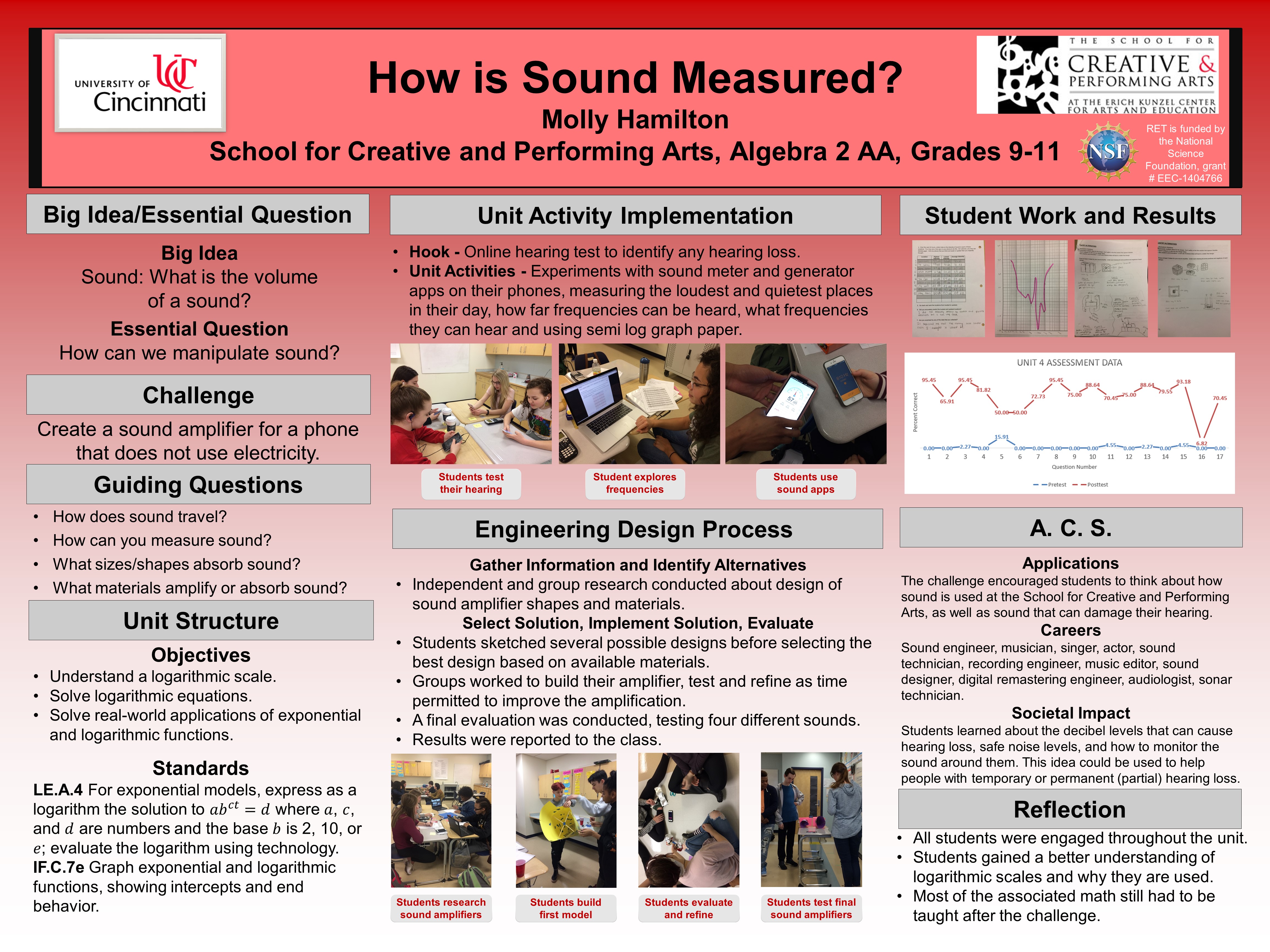Research Experience for Teachers (2017-2018)
Unit 4 Series, Exponential, and Logarithmic Functions: How is Sound Measured – How can you change the volume of a sound?
 |
||||||
|
||||||
|
Pre/Post Test: Pre-Test Post-Test |
||||||
Keywords:
|
|
The Big Idea (including global relevance) Noise pollution and Sound: How can you change the volume of a sound? Noise pollution is all around us. It is any annoying or distressing sound that interferes with sleep, daily activities or negatively affects one’s quality of life (“Clean Air Act Title IV - Noise Pollution,” 2017), but it really depends on an individual’s perspective. It can cause temporary or permanent hearing loss. However, even noises that are not considered pollution can damage one’s hearing. Sounds are used or manipulated for many different reasons: alarms, emergency notification, communication, music, interference, expression, and to add depth to a scene or environment, as well as many more. |
|
Essential Questions
|
|
The Hook Students will complete a hearing test online to see if they have any hearing loss. Students will also identify the loudest and quietest environments they are in during the course of their day/week. |
|
The Challenge Create a sound amplifier that does not use electricity. |
|
Guiding Questions
|
ACS (Real world applications; career connections; societal impact)
Sound is something we encounter on a daily basis. An important aspect of sound is making sure that we are hearing sound at an acceptable range. Another side to that is that sound needs to be loud enough to be heard. At SCPA, students are frequently performing for an audience. They rely on electronics to amplify the various sounds that they are producing. What would happen if they didn’t have access to these electronics?
A good solution can be used to share performance arts with the community. Students will spread the word about their research and solutions through a public service announcement, video, or brochure. This product could be used for people with temporary or permanent (partial) hearing loss, or to enhance communication, music, or artistic performance.
Sound Engineer, Singer, Actor, Musician, Sustainability Coordinator, Audiologist, Sound Technician, Forensic Audio Specialist, Audio Archivist, Sound Designer, Recording Engineer/Mixer, Acoustic Consultant, Digital Remastering Engineer, Recording Equipment Representative, Mastering Engineer, Recording Studio Setup Worker, Music Editor, Audio Developer, Sonar technician.
Misconceptions
- Quantifying sound – what can we measure and how changing one characteristic of sound effects or another characteristic.
- Logarithms, logarithmic scales, and their applications.
Unit Lessons and Activities
- Lesson 1: Decreasing the Volume of a Sound – (5 days)
Lesson 1 will focus on giving the students an understanding of sound, how sound is measured, and why and how to decrease the volume of a sound. Students will collect sound data in their environment to see what are the loudest and quietest environments they are in over the course of a day or week.- Activity 1 : Introduction of the Big Idea, Generating the Essential Question, Challenge and Guiding Questions. (2.5 days)
- Activity 2 : Determine what frequencies they can hear and how far away they can hear them. (2.5 days)
- Lesson 2: Increasing the Volume of a Sound – (5 days)
Lesson 2 will focus on understanding decibels, logarithms, and why and how to increase the volume of a sound. Students will collect data about how far away they can hear different frequencies.- Activity 3: Determine how far away a certain frequency can be heard at a given decibel level. (1 day)
- Activity 4: Create a noise amplifier. (4 days)
- Evidence of CBL: Lesson 2, Activity 4
- Evidence of EDP: Lesson 2, Activity 4
Additional Resources
http://www.starkey.com/online-hearing-test
http://www.sciencebuddies.org/science-fair-projects/project_ideas/HumBio_p011.shtml
